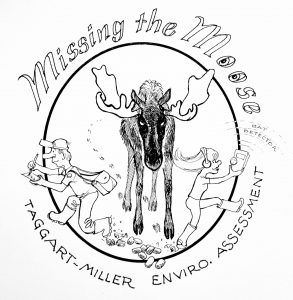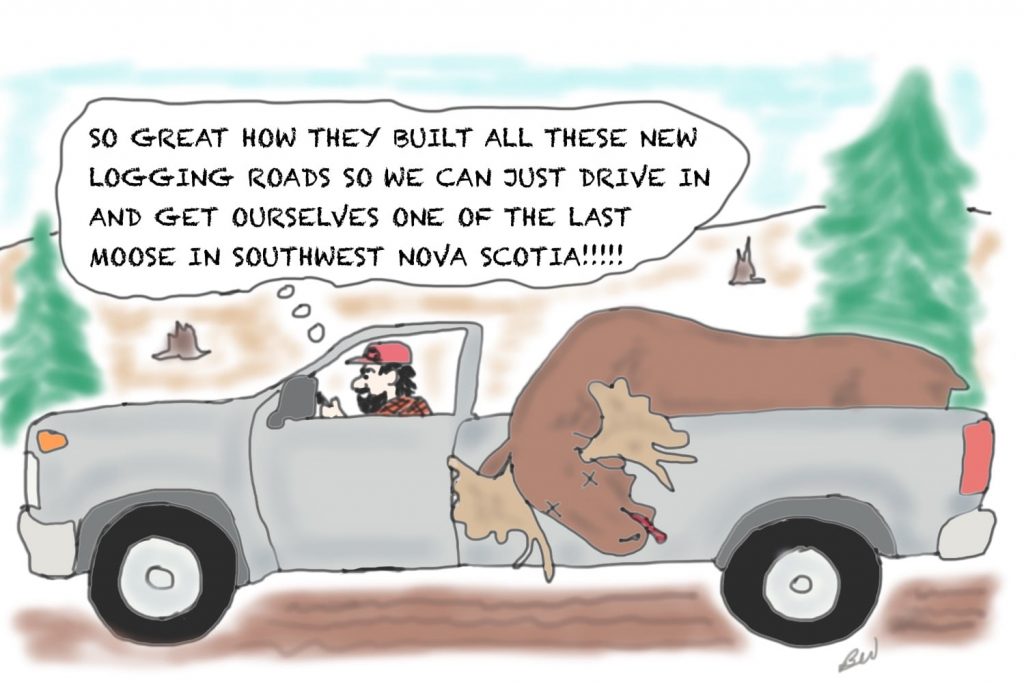OP ED – I submitted this to the Chronicle-Herald about a week ago, but it looks like it won’t make the cut – the “opinion” section has been filled with rants about Trump and U.S. politics – so local issues seem to be drowned out for now. Anyhow, rather than let the piece go to waste, I will post it here. Bev Wigney on Annapolis Royal & Area – Environment & Ecology, Jan 13, 2021
=============================================
Who Shall Protect The Moose?
 In a 1981, biologist P.T., was tasked with studying and evaluating the impact of a proposed access road for mining exploration – a road that might threaten a remnant moose population in a remote
In a 1981, biologist P.T., was tasked with studying and evaluating the impact of a proposed access road for mining exploration – a road that might threaten a remnant moose population in a remote
area of southwest Nova Scotia. A thorough study was completed and a report written for the Department of Lands & Forests. It was
published as “An Evaluation of Moose Habitat In South Western Nova Scotia (1981)”. This report was passed along to me by someone who kept it safely filed in their cabinet for forty years. They wished to share it after learning of the recent “Moose Blockade” attempts to protect Mainland Moose in the remote area of Digby County between the Tobeatic and the Silver River.
P.T.’s report and his “moose maps” identified that area as being important to moose. From his summary on page 8, he states: “Poaching of this slow reproducing moose population would certainly result from the construction of an access road and, therefore, threaten these isolated animals. The small size of this unique area cannot provide both mining and wildlife interests. Decision makers will have to make a choice.” Further he states: “Since this study was conducted with wildlife interests in mind, it is recommended that mining operations and access roads be discouraged in this unique wilderness area. It is also recommended that the area be declared and protected as one of the last “wilderness” areas in Nova Scotia.”
Fast forward to now. The purpose of the recent “Moose Blockade” activity was an attempt by concerned citizens, to stall further building of logging roads and forest harvesting activity into this remote pocket of wilderness. The Moose Blockade people asked for a freeze on current and further industrial activity until an independent study could be done on this area where residents of Digby County have reported longtime Moose activity — activity that is also indicated in P.T.’s study and maps. They asked for a study to determine “core habitat” that should be protected for Mainland Moose. Sadly, their requests were not welcomed by the Department of Lands & Forestry. Their request for online meetings with the Minister were also not welcomed — and, in fact, received no acknowledgement. Instead, their actions and requests ultimately triggered the arrest of nine of the many people who participated in or supported the Moose Blockade.
So, now forestry operations are rolling ahead — more logging roads are being forged into this last pocket of Moose territory — all with feeble assurances that they’ll leave some “moose clumps” of trees as per following instructions for Special Management requirements. However, the very construction of new roads into that area will disturb any Moose that happen to inhabit that area. Roads will invite poachers. Roads will invite coyote packs that can run on them for easy access to predate the Moose that have sheltered in mature forests where depth of snow would have deterred the coyote. The extensive cutting of forest will attract White-tailed Deer that carry the “brainworm” that is so deadly to Moose. Meanwhile, the Department of Lands and Forestry will continue to “explain” that Moose move around a lot, so protection of specific areas is not required. Oddly, this belief is not backed up by science. In their paper, “Complexity and Information Gaps in Recovery Planning For Moose in Nova Scotia”, Beazley et al. write: “Moose have a relatively small home range and show strong fidelity to a geographic area (Youmans 1999). Use of selected areas is learned and traditional with the home range of individual animals encompassing adequate resources to meet their basic year-round needs of water, food, cover, and security.” P.T. indicates much the same in his 1981 study.
It is most shameful that the Department of Lands & Forestry, in its apparent lack of infinite wisdom, appears to not even follow the recommendations cited in a very thorough survey and report that should be easily accessed in its own files. Further, it seems unwilling to embrace the research and findings of biologists based here in our own province. It is also shameful that the people of the Moose Blockade were arrested and must now defend themselves in court for attempting to protect the dwindling, endangered remnant population of Mainland Moose in southwest Nova Scotia. Last May, then Minister of Lands & Forestry, Iain Rankin, was admonished by Judge Brothers of the Supreme Court of Nova Scotia for not adequately protecting the Mainland Moose and several other Species At Risk in this province. Where is the responsibility that should have been demonstrated after that legal decision? Why has it fallen to caring citizens to attempt to protect Species At Risk, thereby putting themselves into jeopardy of being arrested and having to defend themselves in court? I find these matters to be extremely disturbing. Who now shall protect the Moose?

